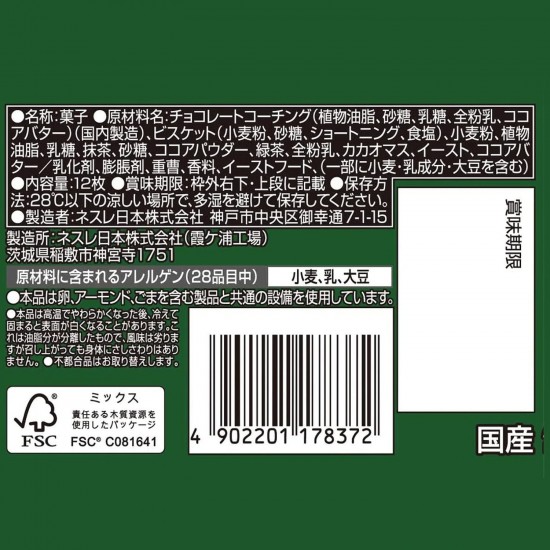-550x550.jpeg)

-80x80.jpeg)

- Stock: In Stock
- Model: 1232
Product details
Crushed biscuits are kneaded into the Uji green tea-flavoured dough to create an authentic adult bitter taste with the 'deep bitterness' and 'sharp aftertaste' of green tea.
The crispy wafers, unique to Kit Kat, are matched with the deep bitter taste of dark matcha green tea.
The bright, dark green shade of matcha chocolate is reminiscent of elegant and delicious matcha.
The aroma of matcha green tea that spreads the moment you open the bag is also irresistible.
In between work, during breaks, when you take a breather at home... individually wrapped, you can enjoy Kit Kat Mini Dark Matcha at your favourite time of day.
Messages can also be written on the individual wrappings, so you can pass on your feelings of gratitude and other messages along with the Kit Kat.
The dark matcha green tea is bitter and sweet, with a delicious taste that you will want to repeat.
| Manufacturer Name | Nestlé Japan |
| Brand name | Kit Kat |
■ Allergenic substances in raw materials (out of 28)
Wheat, milk, soy bean
※This product shares equipment with products containing egg, almond and sesame.
■Ingredient name
Chocolate coaching (vegetable fats, sugar, lactose, whole milk powder, cocoa butter) (manufactured in Japan), biscuits (wheat flour, sugar, shortening, salt), wheat flour, vegetable fats, lactose, matcha, sugar, cocoa powder, green tea, green tea, whole milk powder, cocoa mass, yeast, cocoa butter/emulsifier, leavening agent, flavouring, baking soda. Yeast food, (contains some wheat, milk ingredients and soya).
■Nutrition Facts (per sheet 11.3 g)
| Energy | 64kcal |
| Protein | 0.47g |
| Lipids (Saturated fatty acids) | 4.0 g (2.4 g) |
| Carbohydrate (Saccharinity) (Saccharides) (Dietary fiber) | 6.7 g (6.5 g) (4.5 g) (0.09-0.29g) |
| Salt Equivalent | 0.01-0.05g |
※Polyphenols (tea catechins) 30-50 mg per sheet (standard 11.3 g).
■Storage method
Store in a cool place below 28°C (82°F) and away from high humidity.
The surface of this product may turn white when it cools and hardens after softening at high temperatures.This is a separation of fats and oils, which is inferior in flavour but does not harm the body when consumed.
Kit Kat packaging goes from plastic to 'paper'.
Kit Kat was created in the UK in 1935 and launched in Japan in 1973.
Since then, various flavours of Kit Kat have been launched and it remains a very popular product.
Kit Kat has changed the outer bag of the large bag type from plastic to paper packaging from September 2020.
By the end of the same year, a total of 420 tonnes of plastic had been reduced.
Nestlé Japan aims to make 100% of its packaging materials recyclable or reusable by 2025.
For a future that will last forever, Nestlé Japan is taking one step at a time.



